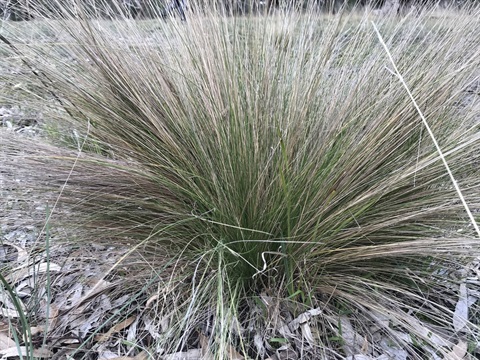
It's week six of Council's Weed of the Week series for the 2024/25 spring and summer season. This series of articles provides our community with information and advice on new, emerging and established invasive plant species threatening our region.
Whether you're living on the land, living in town, or just passing through – we all have a part to play in protecting our natural environment and agricultural land from invasive plants and weeds.
This week we look at serrated tussock, arguably one of the worst weeds in the Snowy Monaro region. Serrated tussock (Nassella trichotoma) is a perennial, grassy weed that is not palatable to livestock and can quickly dominate disturbed pastures.
A single plant can produce up to 140,000 seeds each season. Serrated tussock is very difficult to eliminate, control is costly and herbicides used to control serrated tussock impact other grasses, especially natives.
Serrated tussock plants seed prolifically, normally during November. At this time they are most easily distinguished by their drooping, purple seed-heads, which typically detach and disperse by Christmas time. Seeds are easily dispersed by wind, water, animals, vehicles and fodder, giving them the ability to populate new and remote areas.
Due to its invasive impact on both agriculture and the environment, serrated tussock should be strategically targeted by public and private land managers to limit seeding and minimise spread.
Tips for managing serrated tussock:
- Number one rule: Maintain strong, competitive pastures to inhibit Serrated Tussock establishment. Disturbed ground and weak pastures = weeds.
- Plan to control all serrated tussock before it produces seeds. One year of seeding means many years of weeding.
- Decide what control methods are most appropriate to your situation:
- Manual removal or spot spraying is most effective for managing isolated or light infestations and minimises ground disturbance
- Boom spraying and long-term pasture renovation strategies are most effective at managing heavy infestations on arable land (giving consideration to the legal restrictions on clearing native vegetation/grasslands)
- Non-chemical options include digging or chipping out the plants. You can scatter grass seed over larger bare areas to help stop weeds from growing.
- Consider whether you have the time, equipment and ability to do the work yourself. It might be more practical and efficient to engage a contractor to do the work on your behalf.
- Coordinate your weed control efforts with your neighbours. You may be able to share resources and achieve more effective results.
- Flupropanate and glyphosate are most commonly used for controlling grassy weeds like Serrated Tussock.
- From September onwards, a mixture of flupropanate and glyphosate will prevent seed set. Refer to Australian Pesticides and Veterinary Medicines Authority permit 9792.
- Use glyphosate on actively growing plants only. Glyphosate is absorbed through the leaves of plants and acts very quickly, but it is not selective and will kill most plants on contact.
- Flupropanate is a more selective, longer-acting herbicide that is absorbed mostly through the roots of plants. Flupropanate can take several months to kill grassy weeds and can remain active in the soil for several years.
- Ensure that you rotate herbicides regularly to reduce resistance issues. Consider using flupropanate through the winter months and mop up remaining plants with glyphosate in the warmer months when plants are actively growing.
As with all weeds, prevention is the best control option. Maintaining a vigorous perennial ground cover at all times will inhibit the establishment of serrated tussock seedlings.
What are my lawful control requirements?
Serrated tussock is subject to mandatory measures under the Biosecurity Act 2015. These measures mandate that serrated tussock must not be imported into the state, sold, bartered, exchanged, or offered for sale. The Biosecurity Act 2015 does not, however impose the strict control requirements on land managers that were formerly required under the repealed Noxious Weeds Act 1993.
The NSW Weed Risk Management framework has identified that while serrated tussock and other local priority weeds continue to pose a high risk to the economy, environment and community, they are so widespread that the cost of maintaining a program of regulatory intervention is too high for the community to sustain.
Under current legislation, land managers can determine how best to manage serrated tussock on their land, based on their individual circumstances.






